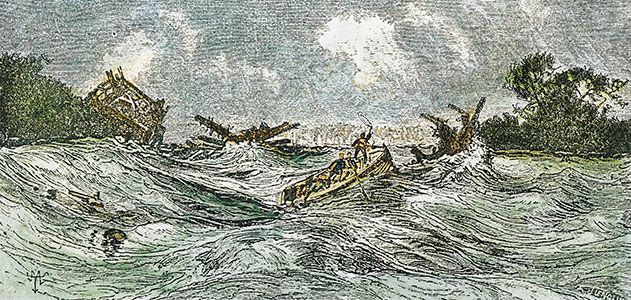
Two weeks ago, after a moderate earthquake shook the small towns and farms of southern Illinois, geologists reminded us that the Midwest is an active seismic zone.
Even though we’re used to thinking that the upcoming Big One will feature swaying skyscrapers in Los Angeles or San Francisco, it’s just as likely that Memphis or St. Louis will be the next major metro area to experience some serious horizontal earth movement.
That’s because the New Madrid seismic zone – which underlies the spot where Tennessee, Kentucky, Illinois, Missouri, and Arkansas come together – has produced massive quakes in the recent past.
During the winter of 1811-1812, three enormous earthquakes – estimated to have registered between 7.2 and 8.6 on the Richter scale – radically changed the landscape.
The area was sparsely populated at the time. But several small communities, including New Madrid, Missouri (for which the zone is named), were flattened. Earthen banks along the Mississippi River collapsed. The water seemed to roil and boil, as depicted in the woodcut above. Massive uplifts under the river temporarily produced gigantic waterfalls. For a few days the Mississippi even flowed backwards.
The last and biggest of the three quakes, in February 1812, created Reelfoot Lake in northwestern Tennessee. “Geysers” of sand and soil shot up along a line almost fifty miles long. Buildings shook in New Orleans, and the tremors rang church bells in faraway Boston.
The New Madrid zone has long puzzled geologists. It’s not a classic rift or crustal boundary, like the San Andreas fault in California (where Dwayne “The Rock” Johnson looks exceedingly ripped while rescuing fellow actors).
But everyone agrees that the tremors emanating from what appears to be a deep underground “wound” didn’t end two centuries ago.
More than 4,000 quakes of various intensities have been recorded in the area since 1974. Some geologists believe that New Madrid is overdue for a cataclysm, and suggest a 10% chance that a major earthquake will happen in the area between now and the middle of the 21st century.
If that happens, the consequences won’t be trivial. If the Cardinals happen to be playing a home game in St. Louis at the time, their biggest worry won’t be the opposing pitcher. Millions of people currently live up and down that part of the Mississippi Valley, and economists estimate a major quake would produce the most costly disaster in American history.
In 1812, there were only a handful of native American tribes and a few white settlers in the area. What everyone agreed at the time is that those quakes simply had to mean something.
Some of the tribes concluded that the disaster was a summons to join the pan-Indian alliance of Chief Tecumseh. The whites, meanwhile, figured that the falling trees, reconfigured rivers, and spewing geysers must be signs of the Apocalypse.
We don’t always notice the number of earthquakes that are reported in the Bible. Palestine is also a geologically active area, and some of the quakes in ancient times seem to have been supernaturally timed to coincide with crucial events.
An earthquake shakes Mt. Sinai as a prelude to Moses receiving the Ten Commandments (Exodus 19:18). Some of the most rebellious Israelites are swallowed up by a fissure in the ground (Numbers 16:31). Elijah the prophet experiences a major tremor (I Kings 19:11). So does King Uzziah (Amos 1:1). Paul and his companion Silas are freed from prison in the Macedonian town of Philippi when an earthquake shakes their jail in the middle of the night (Acts 16:26).
Then there are the two earthquakes associated with Jesus’ last weekend. One rocks Jerusalem after he dies on the cross (Matthew 27:51-54), and the other shakes the earth at his resurrection (Matthew 28:2).
The most interesting (and overlooked) quake in the Gospels happens when Jesus and his disciples are crossing the Sea of Galilee. “But look, a huge quake [the Greek word here is seismos] hit the lake so that the boat was swamped with waves. But Jesus was dead asleep” (Matthew 8:24). In Matthew 14, the disciples are alone in a boat when they are almost swamped by a storm. Jesus comes walking to them on the water. In both cases, he commands the wind and the waves to be still.
The fascinating detail from the first story is that Jesus – in whom and through whom flows all the power in the universe – is “dead asleep.”
God is sleeping through an earthquake.
His disciples have to wake him up. “Lord, don’t you care that we’re facing this horrible moment? Don’t you care that our lives are on the line?”
That’s still what people want to know. Will God be taking a nap the next time our lives are being shaken down to the foundations? When a loved one dies, when the money runs out, when depression plunges us into despair, will Jesus check out and leave us to face our darkest days alone?
Jesus, who has nodded off in the boat, is fully human. He needs just as much sleep as any other first century resident of Galilee. But that doesn’t mean he is vulnerable. He isn’t caught off guard. “He arose and rebuked the winds and the sea, and there was a great calm” (Matthew 8:26).
Psalm 121:4 reminds us, “He who watches over Israel neither slumbers nor sleeps.”
That’s another way of saying you will never have to face life’s hardest realities all by yourself.
The earth may shake. Waves may crash.
But God can provide what’s available from no other source:
A great calm.
